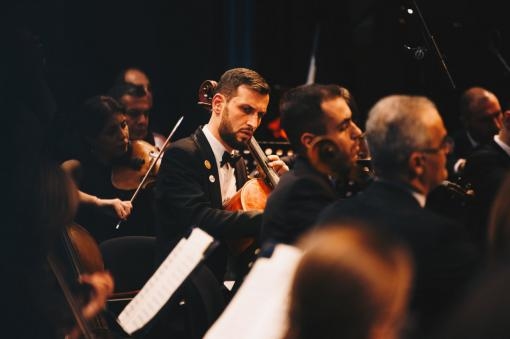Music Festival Moravský podzim (Moravian Autumn) reached its finale yesterday – during seventeen days, the music of composer Jan Novák, works of world minimalists and the works of Armenian artists were performed. It was the Armenian dramaturgical line which closed the 51st year of the festival underway in the hall of the Janáček Theatre. However, it was not Armenian music performed by the Brno Philharmonic, which organises the festival, but the real Armenian Philharmonic Orchestra led by the conductor Eduard Topchjan. The violist Luca Ranieri performed as a soloist and the works of Tigran Mansurian, Avet Terterian and Aram Khachaturian were performed. The concert was held on the occasion of the 30th anniversary of Armenian independence and J.E. Ashot Hovakimian, Ambassador of the Republic of Armenia to the Czech Republic, took patronage over it.
A cross-section of 20th century Armenian orchestral music opened with the Czech premiere of a viola concerto“...and then I was in time again” by Tigran Mansurian, inspired by the novel The Sound and the Fury by American novelist and poet William Faulkner. The composer in an interview from the album booklet Monodia, which includes the aforementioned composition, however, adds that the music is based more on the philosophical background of the work than on a precise description of the plot itself. As in other works by Mansurian, one can find in his viola concerto a deep intimacy, melancholy and perhaps even a kind of anguish, which is, however, far from pathetic or merely empty stylisation. The small orchestra opens the work with an unsettling surface in quiet dynamics, which is then followed by a vigorous viola entrance and a distinctive rhythmic motif that foreshadows where the work will go next. Although Mansurian applies a number of challenging technical elements, it is always the logical outcome of a musical phrase, not virtuosity for its own sake. Luca Ranieri gave a fine performance of a piece of work that is difficult to interpret, although compared to Kim Kashkashian, for whom Mansurian originally composed the work, he grasped the viola part of the first movement Allegro, quasi recitando in a much less expressive manner. On the contrary, in the second movement Lento, cantando the violist’s more restrained and, in a good sense, “cooler” take on the piece fell on fertile ground.
In a completely different compositional language – the intention of the evening was to present the different faces of Armenian musical culture – Symphony No. 3 by Avet Terterian spoke to the audience: a powerful orchestral apparatus with a strong representation of percussion and traditional instruments of Armenian music. While Mansurian’s viola concerto opened with a fragile and unsettling musical surface, Terterian’s symphony opens with a vigorous percussion entrance that, in the Buddhist tradition, prepares those present for the ensuing silence and (musical) meditation. The subsequent glissandos of the trombones – later also with mutes – foreshadow a completely different musical world. Time seems to lose its importance and the long notes together with the more or less empty musical texture only deepen this feeling. But Terterian’s symphony is largely based on extremely stark contrasts – the listener is taken out of the timelessness of Buddhist meditation by the sharp sound of the zurna, which is then joined by horns and soon by other instruments – the music acquires a sharp rhythmic pulse and a partly minimalist character. It should be added that the conductor Eduard Topchjan was well aware of the purposes of the various surfaces of Terterian’s symphony and skilfully accentuated the contrasting aspects of the composer’s music. In fact, when the mournful duduks came to the fore in the second movement, he made sure that the percussion instruments, which now and then entered their duet, only added a subtle colour to the fragile and slowly flowing melody. In the third movement, on the other hand, he drove the orchestra to an almost deafening forte fortissimo, and yet he balanced the dynamics so that no instruments were lost in the rich score.
The final part of the evening was Symphony No. 2 in E minor by Aram Khachaturian. While the two preceding pieces benefit more from a modern compositional language, Khachaturian’s symphony speaks to the audience using mostly traditional musical methods. However, this does not detract from its charm, and I dare say that one “could not wish for” a better dramaturgical conclusion to a remarkable full-length programme. For although Soviet aesthetics favoured its own ideal, Khachaturian managed to implement in his works distinctive elements of Armenian music, which are also central to this symphony. The orchestra under the direction of Eduard Topchjan not only managed to infuse the dramatic composition with a bright and lively energy, but also in the delicate and purely lyrical passages the conductor’s sense of musical phrasing was evident, which he also supported with varied dynamics.
The final concert of the Moravian Autumn was a monumental cross-section of Armenian music and at the same time an overview of different compositional approaches and ways in which artists deal with an establishment that is not favourable to music. In addition, more than a hundred musicians celebrated not only the music of their composers, but also the 30th anniversary of their independence. And it was this message which put a figurative crown on the last evening of the 51st Moravian Autumn festival.
TIGRAN MANSURIAN
“...and then I was in time again”, viola concerto
AVET TERTERIAN
Symphony No. 3
ARAM KHACHATURIAN
Symphony No. 2 E Minor
Luca Ranieri viola
Armenian Philharmonic Orchestra
Conductor: Eduard Topchjan
17 October 2021, Janáček Theatre
































No comment added yet..